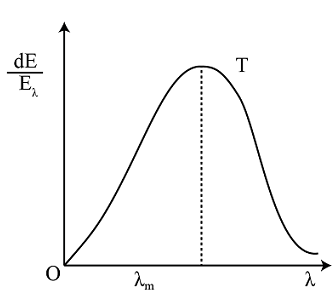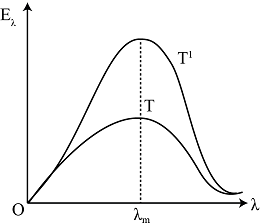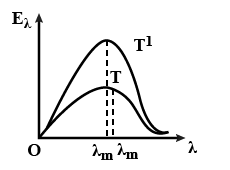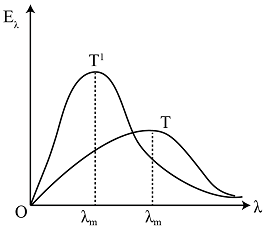
The figure shows a radiant energy spectrum graph for a black body at a temperature T. Identify the graph which correctly represents the spectral intensity versus wavelength graph at two temperatures $\mathrm{T}^{\prime}$ and $\mathrm{T}\left(\mathrm{T}<\mathrm{T}^{\prime}\right)$ :

A. 
B. 
C. 
D. None of these
Answer
219.3k+ views
Hint: Find the proper diagram from the graphs provided here, which show the spectral intensity versus wavelength at two different temperatures and the radiant energy spectrum for a blackbody. You must identify the idea that may be utilized to calculate the variation in intensity with respect to wavelength of the radiation emitted by the blackbody at various temperatures in order to respond to this question.
Complete step by step solution:
Once released by any body, thermal radiations become electromagnetic waves similar to light and are subject to all the principles of wave theory. The laws of geometrical optics, such as that radiation travels in a straight line, shadows are cast, reflection and refraction also occur at the boundary of two media, are valid since the wavelength is comparable to the sizes of commonly used objects. The explanation above served as a primer on radiation and to inform you that since radiations are essentially electromagnetic waves, it is inevitable that each wave would have a specific wavelength.
A body's radiation is made up of a variety of waves of varied wavelengths, but only a specific range of wavelengths is significant in terms of its contribution to the radiation. The wavelength is greatly influenced by the temperature of the emitting substance. The graph of intensity versus wavelength is used to investigate the nature of thermal radiation.
According to this, the wavelength that corresponds to the greatest intensity shifts to the left as the temperature rises, which means that the wavelength decreases. As a result, the second graph is the one that accurately represents the spectral intensity versus wavelength graph.
Therefore, the correct answer is option B.
Note: The important thing to note is that, although our discussion of the conditions was brief, option (C) also satisfies them. Option (C) is erroneous since it is impossible for the curve with temperature $T$ to be greater than the curve with temperature $T^{\prime}$. Always place the curve with high temperature above the curve with relatively low temperature.
Complete step by step solution:
Once released by any body, thermal radiations become electromagnetic waves similar to light and are subject to all the principles of wave theory. The laws of geometrical optics, such as that radiation travels in a straight line, shadows are cast, reflection and refraction also occur at the boundary of two media, are valid since the wavelength is comparable to the sizes of commonly used objects. The explanation above served as a primer on radiation and to inform you that since radiations are essentially electromagnetic waves, it is inevitable that each wave would have a specific wavelength.
A body's radiation is made up of a variety of waves of varied wavelengths, but only a specific range of wavelengths is significant in terms of its contribution to the radiation. The wavelength is greatly influenced by the temperature of the emitting substance. The graph of intensity versus wavelength is used to investigate the nature of thermal radiation.
According to this, the wavelength that corresponds to the greatest intensity shifts to the left as the temperature rises, which means that the wavelength decreases. As a result, the second graph is the one that accurately represents the spectral intensity versus wavelength graph.
Therefore, the correct answer is option B.
Note: The important thing to note is that, although our discussion of the conditions was brief, option (C) also satisfies them. Option (C) is erroneous since it is impossible for the curve with temperature $T$ to be greater than the curve with temperature $T^{\prime}$. Always place the curve with high temperature above the curve with relatively low temperature.
Recently Updated Pages
Two discs which are rotating about their respective class 11 physics JEE_Main

A ladder rests against a frictionless vertical wall class 11 physics JEE_Main

Two simple pendulums of lengths 1 m and 16 m respectively class 11 physics JEE_Main

The slopes of isothermal and adiabatic curves are related class 11 physics JEE_Main

A trolly falling freely on an inclined plane as shown class 11 physics JEE_Main

The masses M1 and M2M2 M1 are released from rest Using class 11 physics JEE_Main

Trending doubts
JEE Main 2026: Application Form Open, Exam Dates, Syllabus, Eligibility & Question Papers

Understanding Uniform Acceleration in Physics

Derivation of Equation of Trajectory Explained for Students

Hybridisation in Chemistry – Concept, Types & Applications

Understanding the Angle of Deviation in a Prism

Understanding Collisions: Types and Examples for Students

Other Pages
JEE Advanced Marks vs Ranks 2025: Understanding Category-wise Qualifying Marks and Previous Year Cut-offs

Units And Measurements Class 11 Physics Chapter 1 CBSE Notes - 2025-26

NCERT Solutions For Class 11 Physics Chapter 8 Mechanical Properties Of Solids

Motion in a Straight Line Class 11 Physics Chapter 2 CBSE Notes - 2025-26

NCERT Solutions for Class 11 Physics Chapter 7 Gravitation 2025-26

Understanding Atomic Structure for Beginners




